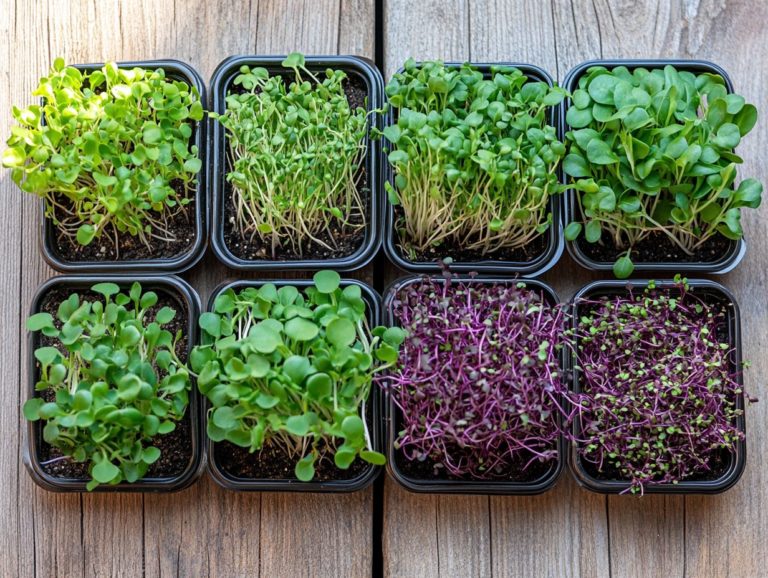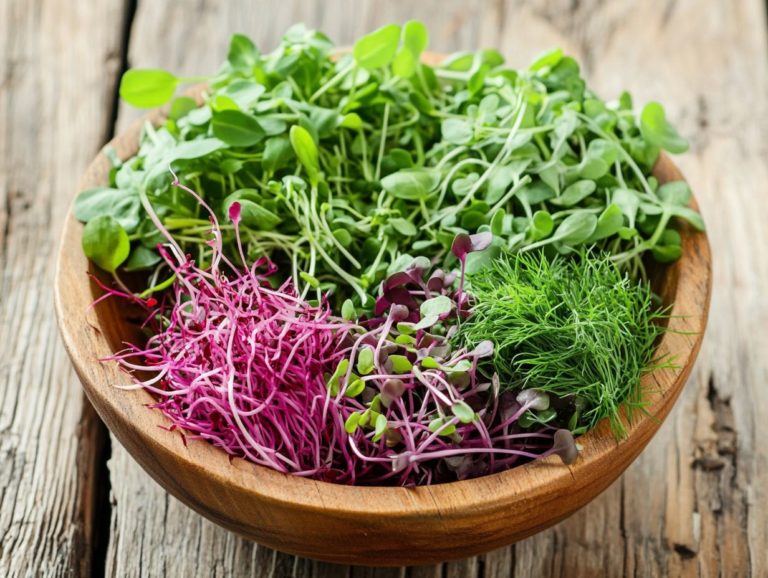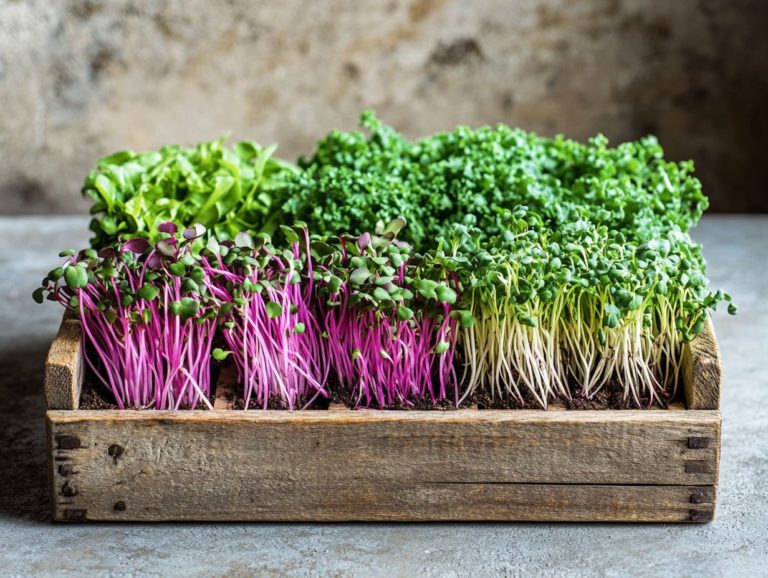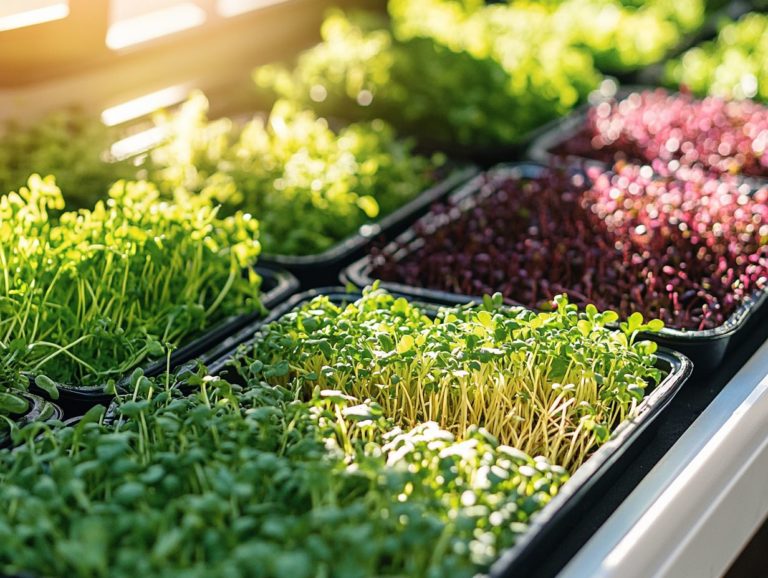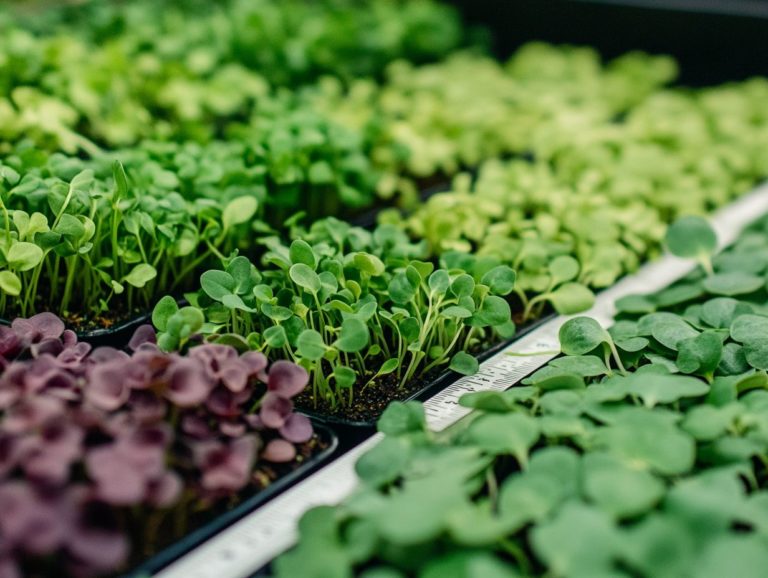Microgreen Varieties: A Guide for Beginners
Microgreens are small, nutrient-rich plants that have taken the culinary scene by storm. These vibrant greens not only elevate the flavor and visual appeal of your dishes but also provide a multitude of health benefits.
In this article, get ready to discover the many advantages of growing microgreens, including their remarkable nutritional profile and cost-effectiveness. You’ll learn how to select the right varieties, follow a detailed step-by-step growing guide, and steer clear of common pitfalls.
Don t miss out on the chance to supercharge your meals with these vibrant greens today!
Contents
- Key Takeaways:
- Benefits of Growing Microgreens
- Choosing the Right Microgreen Varieties
- How to Grow Microgreens
- Harvesting and Using Microgreens
- Common Mistakes to Avoid
- Frequently Asked Questions
- What are microgreen varieties?
- Why are microgreen varieties popular among beginners?
- What are some common microgreen varieties for beginners?
- How do I choose the right microgreen variety for my needs?
- Can I mix different types of microgreens together?
- What are some tips for growing microgreens for beginners?
Key Takeaways:
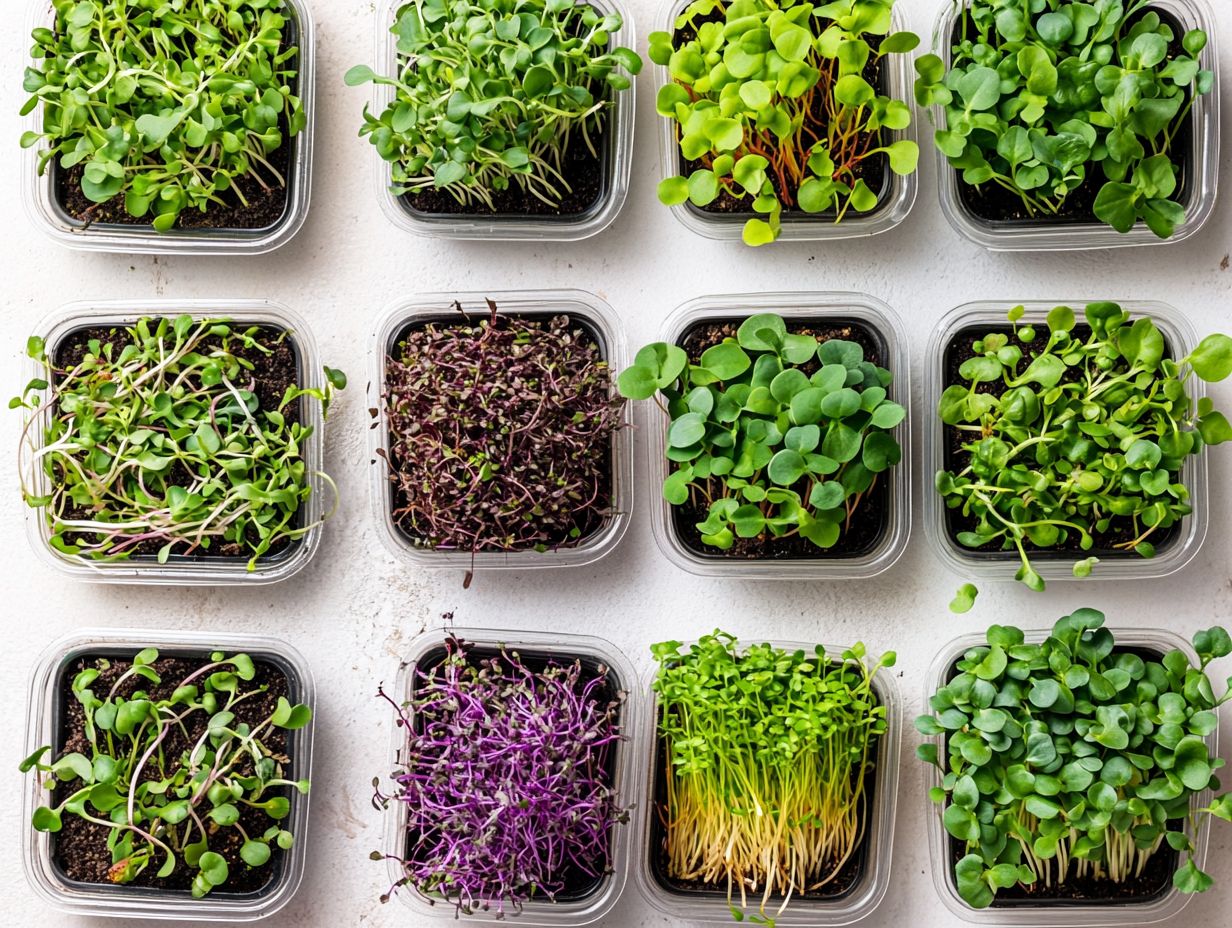
- Microgreens are young plants harvested after sprouting, packed with nutrients and easy to grow at home.
- Growing microgreens saves money and provides a nutritious boost to meals. Consider factors like taste, ease of growth, and space availability when choosing varieties.
- Grow microgreens with a simple step-by-step process, and harvest and use them in various dishes for added flavor and health benefits. Avoid common mistakes by following expert tips for successful growth.
What are Microgreens?
Microgreens are the young, edible plants you ll want to harvest just after they ve developed their first true leaves. They add a burst of color and flavor to a variety of dishes, making your home cooking all the more vibrant.
Packed with intense flavor and superior nutrient content compared to their mature counterparts, microgreens have become a favored choice among high-end chefs, urban farmers, and avid home gardeners alike.
Varieties such as pea shoots, radishes, and mustard greens can be easily cultivated indoors, providing an eco-friendly source of fresh produce all year round.
What s truly remarkable is their growth cycle often just 7 to 21 days from seed to harvest. This means you can quickly refresh your culinary supplies and keep your meals exciting. The rapid growth has fueled their rise in popularity among chefs, who appreciate how these tiny greens can elevate dishes both in visual appeal and flavor.
Home cooks are catching on too, recognizing the versatility and richness in nutrients of microgreens, which include essential vitamins A, C, E, and K, along with vital minerals. For a deeper understanding, you can explore the nutrient comparison of popular microgreen varieties. As more individuals embrace health-conscious and plant-based diets, these miniature greens are undeniably carving out their own niche in modern kitchens worldwide.
Benefits of Growing Microgreens
Growing microgreens offers a wealth of benefits, making them an enticing option for both novice gardening enthusiasts and experienced urban farmers. These tiny powerhouses are renowned for their impressive health benefits, brimming with nutrients that can elevate the flavor profile of your meals and enhance your culinary experiences. The growing process is straightforward and delivers swift results, making indoor gardening a breeze for anyone eager to cultivate their own nutritious greens at home.
Nutritional Value and Cost Efficiency
Microgreens present a cost-effective solution for your home gardening endeavors, all while delivering exceptional nutritional value that can elevate your diet. These petite powerhouses are loaded with vitamins, minerals, and antioxidants, significantly enhancing your plant nutrition.
The health benefits they offer far exceed their modest price, making them an appealing choice for urban farming enthusiasts and home cooks alike. Unlike their larger counterparts, microgreens deliver a concentrated dose of nutrients, often boasting higher levels of vitamins A, C, E, and K. For those looking to enhance their culinary creations, exploring the top microgreen varieties for gourmet cooking can be particularly rewarding.
Research reveals that these tiny plants can offer up to 40 times more nutrients per serving compared to full-grown vegetables. Plus, they can be effortlessly cultivated in compact spaces, making them perfect for those of you with limited gardening room.
By dedicating just a small amount of time and resources, you can enjoy the fruits of your labor, effectively cutting down on grocery bills while enriching your health with a delightful array of flavors and nutrients.
Choosing the Right Microgreen Varieties
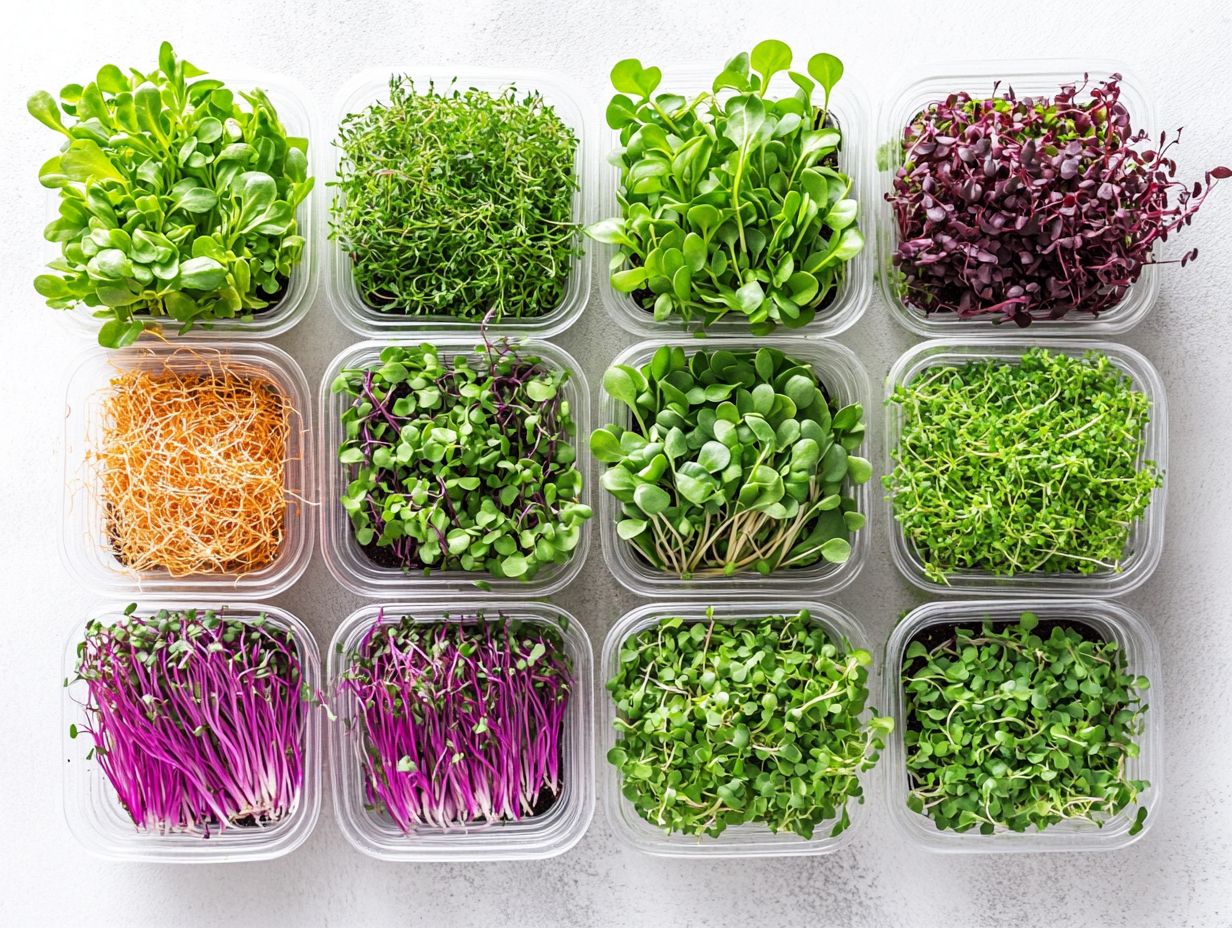
Choosing the right microgreen varieties enhances flavor and nutrition. Each seed offers unique qualities. This opens the door to exciting cooking options and health benefits!
Imagine the peppery kick of mustard greens alongside the sweet crunch of pea shoots each variety is tailored to elevate different dishes. If you have a penchant for growing plants indoors, incorporating microgreens into your routine can transform your meals year-round.
With this method, you’ll always have fresh, vibrant ingredients at your fingertips, ready to elevate your culinary creations.
Factors to Consider
When selecting microgreen varieties, consider key factors such as moisture levels, sunlight exposure, and the type of growing media. Prepare your environment with sufficient sunlight and the right moisture levels to significantly enhance your gardening experience and yield nutritious greens.
The choice of seed sources is paramount; high-quality, organic seeds often lead to better germination rates and healthier plants. For those interested in microgreens, refer to a quick guide to common microgreen varieties to explore options. Be mindful of air circulation and temperature control, as these factors can help prevent mold and diseases that often affect microgreens.
Implementing best practices like rotating crops and providing adequate nutrients creates a resilient growing environment. By focusing on these essential components, you cultivate an ideal setting for vibrant and flavorful microgreens, leading to bountiful harvests and satisfying gardening success.
How to Grow Microgreens
Growing microgreens is an accessible endeavor that promises swift results, making it a perfect project for those venturing into growing plants indoors.
By using growing trays and carefully choosing your seeds, you can establish an optimal growing environment. This guide walks you through every step, from planting the seeds to managing moisture levels and ensuring they receive sufficient sunlight, ultimately leading to a bountiful harvest!
Step-by-Step Guide
This simple guide makes growing microgreens easy! Even as a beginner, you can achieve success in your indoor gardening endeavors.
With the right approach, you’ll discover that cultivating these nutrient-dense greens can be both rewarding and enjoyable. Start by carefully selecting your seeds; consider popular choices like broccoli, radish, and basil, each offering distinct flavors and health benefits. For a detailed process, check out this step-by-step guide to sowing microgreens.
After you’ve chosen quality seeds, prepare your growing trays by adding a suitable growing medium, such as coconut coir, made from coconut husks which retains moisture well, or potting soil, which provides essential nutrients. Once your seeds are evenly spread and lightly covered, it s crucial to maintain optimal moisture levels by misting them daily, ensuring they don t dry out.
As growth progresses, remember to provide adequate sunlight, either by placing your trays near a bright window or using grow lights to encourage robust, healthy development.
Harvesting and Using Microgreens

Harvesting microgreens is rewarding! Snip them at the soil line with scissors to add vibrant flavors to your dishes.
Understanding the optimal timing and techniques for harvesting these tender greens can significantly elevate their taste and nutritional benefits, especially when you explore seasonal microgreen varieties for year-round growth, ensuring you maximize your home gardening efforts.
Tips for Harvesting and Incorporating into Meals
To elevate the health benefits and culinary potential of your fresh microgreens, use the right way to cut your microgreens. These vibrant additions can enhance salads, sandwiches, and a variety of other dishes, offering a delightful crunch along with a nutrient boost! Experiment with different combinations to discover pairings that complement your cooking.
When it s time to harvest, use clean scissors to cut them just above the soil line. This technique prevents disturbing the roots, allowing for future growth while delivering fresher flavors and maintaining the integrity of the remaining plants.
Think about tossing these colorful greens into your omelets, blending them into smoothies for a nutritious kick, or using them as eye-catching garnishes for soups and entrees! Their versatility makes them a delightful topping for pizzas or a flavorful addition to grain bowls, enhancing both taste and visual appeal. For those interested in growing these greens, check out the most profitable microgreen varieties to grow.
Common Mistakes to Avoid
Avoiding common mistakes is essential for anyone aiming to succeed in growing microgreens. Minor oversights can significantly affect your gardening journey.
You ll often encounter pitfalls like incorrect moisture levels, inadequate sunlight exposure, and failing to select the right growing media. Each of these can impact both the growth and flavor of your microgreens.
By learning from these frequent missteps, you can cultivate a flourishing indoor garden that truly delights, especially when incorporating microgreen varieties indoors.
Tips for Successful Microgreen Growing
For a successful journey into microgreen growing, a few key strategies can yield impressive results. Begin with easy-to-grow varieties and keep an eye on moisture levels. Ensure your plants bask in adequate sunlight crucial for healthy growth and vibrant flavor!
Grasping these essentials will enhance your gardening experience and elevate the quality of the microgreens you produce, enabling you to enjoy fresh microgreen varieties as cooking ingredients.
It’s also important to consider factors like temperature and airflow, as they play a vital role in the growth rate and vitality of your microgreens. Aim for a consistent temperature, ideally between 70 F and 75 F, and ensure adequate ventilation to ward off mold and foster robust, healthy plants. Additionally, exploring must-try microgreen varieties for salads can enhance your culinary creations.
Make it a habit to check for pests and diseases regularly; early detection can save your crop! With these strategies in place, anyone can cultivate a thriving microgreen garden, especially by understanding the benefits of growing diverse microgreen varieties.
In summary, prioritize selecting the right seed varieties, maintaining optimal moisture and temperature, providing ample light, and monitoring for issues. This will guarantee a bountiful harvest and allow you to harvest and enjoy your efforts. Start your own microgreen garden today for fresh, flavorful meals!
Frequently Asked Questions
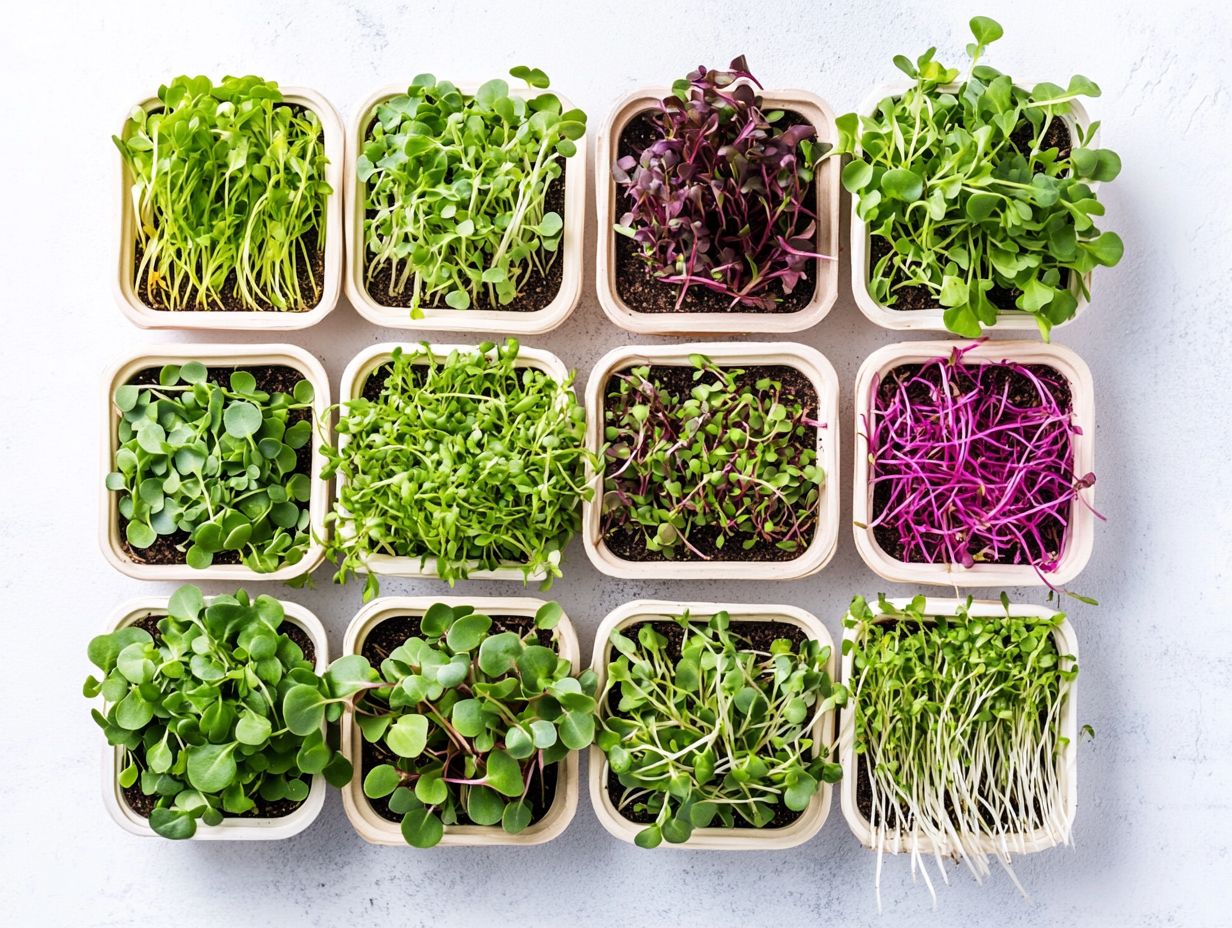
What are microgreen varieties?
Microgreens are young and edible plants harvested at the early stages of growth. They include popular options like pea shoots and radishes. These plants offer a variety of flavors and are packed with nutrients!
Why are microgreen varieties popular among beginners?
Microgreens are easy to grow and require minimal space, making them perfect for beginners with limited gardening experience! Plus, they add a burst of flavor and nutrition to any dish.
What are some common microgreen varieties for beginners?
Some popular microgreen varieties for beginners include broccoli, kale, radish, and sunflower. These varieties are easy to grow and have a mild flavor that is not overwhelming.
How do I choose the right microgreen variety for my needs?
Consider the flavor profile and the difficulty of growing the variety. If you re a beginner, opt for easier varieties like kale and broccoli. Research the flavor profiles of different microgreen varieties before making a decision!
Can I mix different types of microgreens together?
Absolutely! Mixing various types of microgreens adds unique flavors to your dishes.
Choose varieties that grow at the same rate and have similar care needs.
What are some tips for growing microgreens for beginners?
Use high-quality soil and keep the plants well-watered.
Avoid overcrowding by spacing the seeds evenly, and only harvest when the plants reach the perfect height.

